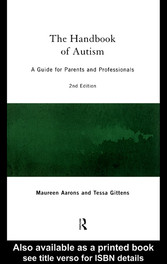
The Handbook of Autism
von: Maureen Aarons
Routledge, 1999
ISBN: 9780203182956
Sprache: Englisch
160 Seiten, Download: 1322 KB
Format: PDF, auch als Online-Lesen
7 SPEECH AND LANGUAGE ( p. 63/64 )
Communication development in children with autism
There are certain characteristics relating to speech and language development which are peculiar to children with autism. First, delay in its acquisition is especially common (and this delay has to be considered in relation to the child’s overall developmental level). Delays in language acquisition may or may not indicate a fundamental language disorder. Normal children acquire language because of a strong and innate desire to communicate. It follows that if the motivation to communicate is impaired, as it is in children with autism, then this will be a contributing factor to the delay in its acquisition (Frith 1989). Indeed, this is often the reason why children later diagnosed as having autism are referred in the first place and why speech and language therapists are so often among the first professionals to become involved.
Parents are likely to report that at the latter end of the first year the child began to acquire speech but then seemed to lose it. If and when speech eventually appears, there is a pattern of deviance which differs from that shown by children with more specific language difficulties. Essentially the problems centre around the use of language. The child may acquire adequate linguistic structures to communicate and indeed may do relatively well in standardised language assessments, but fails to engage successfully in interactive communication. Many studies have been undertaken in recent years to explore the nature of these particular communication problems, and there is now a consensus of agreement, which was not always the case.
Until the notion of a spectrum of autistic disorders was appreciated, able and verbal children with these communication difficulties were frequently diagnosed as having a ‘semantic-pragmatic language disorder’ (S-PD) and any unusual or difficult patterns of behaviour were marginalised or viewed as a consequence of the language impairment. Autism as a possible diagnosis was excluded, since the children did not conform to the classic picture of the condition. Eventually it was understood by even the most fervent advocates of S-PD that it is not possible to have this disorder of communication without an underlying social impairment. Indeed, once the ramifications of theory of mind deficits and poor central coherence were appreciated, the confusion and controversy abated considerably and S-PD is now recognised as a descriptive term for the language and communication problems seen in able and verbal children with autism.
Use of the term as a diagnostic label, without reference to autism, is misleading if not dishonest. It is our view that a focus solely on language and linguistic features, without regard to the child’s mode of being, is inadequate and simplistic. Knowledge of the child’s developmental history and an evaluation of his interests, play, relationships, etc., are essential if the true nature of the difficulties is to be understood. In other words, the presence of autism, however mild or subtle, must be recognised. It is then that the child will make sense. The medical model notion of a disorder has generated considerable muddle among speech and language therapists and other professionals and has prevented them from appreciating the underlying aetiology which is crucial to expectations of outcome.








